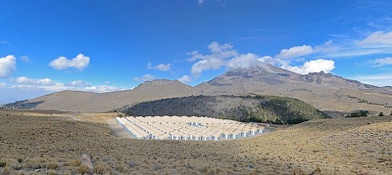HAWC Observatory


The High-Altitude Water Cherenkov (HAWC) Observatory near Pico de Orizaba in Mexico is a detector designed to observe gamma rays and cosmic rays in the energy range from about 100 GeV to 100 TeV. The study of these high-energy particles provides us with a better understanding of some of the most extreme astrophysical objects, from supernova remnants in our Galaxy to extragalactic objects like active galactic nuclei (AGN) and gamma-ray bursts (GRBs).
High-energy gamma-ray emission correlates with sites of cosmic ray acceleration, so the observation of the sky in high-energy gamma rays is a promising approach to understanding the origin of Galactic and extragalactic cosmic rays. Charged cosmic rays cannot be expected to point back to their sources at all but the highest energies because of deflection in magnetic fields. Gamma rays, however, point back to their source. By locating and studying high-energy gamma ray sources, we ultimately hope to understand where and how cosmic rays are accelerated. The measurement of the energy spectrum of gamma-ray sources in the HAWC energy range from TeV to 100 TeV is a key to understanding whether cosmic-ray acceleration takes place in these sources.


HAWC at UW-Madison:
Michael DuVernois
Zig Hampel-Arias
Tom Weisgarber
Stefan Westerhoff
Ian Wisher
HAWC Collaboration
